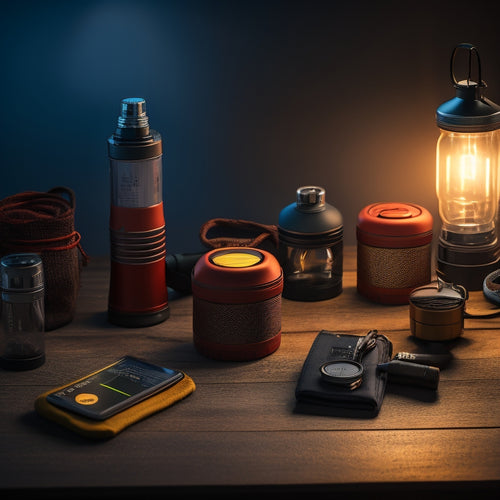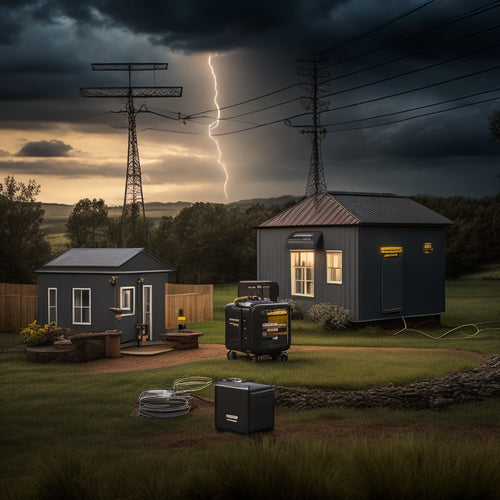
10 Tips for Small Home Renewable Energy Systems
Share
As you initiate the installation of a small home renewable energy system, you'll want to assess your energy needs by calculating daily consumption and identifying areas for reduction. Choose the right solar panels considering efficiency, warranty, and local climate. Optimize roof orientation for maximum sunlight exposure, and select a compatible inverter that meets system specifications and grid connection type. Don't forget to plan for energy efficiency by conducting an energy audit, sealing air leaks, and upgrading insulation. By following these initial steps, you'll be well on your way to a successful installation - and as you continue, you'll uncover even more significant details to guarantee a seamless and efficient shift to renewable energy.
Overview
- Assess your daily energy consumption to determine the required renewable energy system capacity and identify areas for energy reduction.
- Choose the right solar panels based on local climate, roof space, and budget, considering factors like efficiency, warranty, and certifications.
- Select a compatible inverter that meets system specifications, grid connection type, and local electrical standards for optimal energy conversion.
- Ensure proper system sizing by calculating daily energy usage, considering appliance efficiency, insulation, and lifestyle habits to determine peak energy usage times and requirements.
- Regularly inspect and maintain the system, utilizing remote monitoring capabilities to track performance, identify potential issues, and optimize energy production.
Assess Your Energy Needs
Before investing in a small home renewable energy system, assess your energy needs to determine the size and type of system required.
You'll need to calculate your daily energy consumption, considering your lifestyle habits, such as the number of people living in your home, your energy-intensive appliances, and your energy usage patterns.
Conduct an energy audit to identify areas of inefficiency and make accurate assumptions about your energy usage. Track your energy consumption for a month to get an accurate depiction.
This will help you identify areas where you can reduce your energy consumption and determine the capacity of the renewable energy system you need.
Choose the Right Panels
Your renewable energy system's performance hinges on the quality and suitability of its solar panels. When selecting panels, consider the materials used, such as monocrystalline or polycrystalline silicon.
Monocrystalline panels are more efficient, but also more expensive. Polycrystalline panels are more affordable, but slightly less efficient. High-efficiency panels, which boost energy output by up to 45%, are ideal for homes with limited roof space and budget constraints.
You should also look into panel warranties, which typically range from 25 to 30 years. A longer warranty guarantees you're protected from defects and premature degradation.
Additionally, check the panel's certifications, such as UL or IEC, to confirm they meet industry standards for safety and performance.
Optimize Roof Orientation
When optimizing your roof's orientation for renewable energy, you'll want to identify south-facing roof areas that receive the most direct sunlight throughout the day.
This is because south-facing roofs typically receive the most consistent and intense sunlight, making them ideal for solar panel installation.
It's crucial to confirm your solar panels are high-efficiency and durable, with a minimum 25-year warranty, to maximize energy production reliable energy production.
Before proceeding, you'll need to conduct a shading obstruction analysis to determine if any objects, such as trees or neighboring buildings, will cast shadows on your roof and affect energy production.
South-Facing Roof Areas
Position your small home to maximize its south-facing roof areas, as this orientation receives the most direct sunlight throughout the year.
This ideal orientation allows for optimal solar panel placement, considering roof angle factors to guarantee maximum energy harvesting.
Consider seasonal sun exposure to adjust your roof's tilt and orientation for peak performance.
While installation costs may be higher, the increased energy output and reduced reliance on the grid will give you the freedom you desire.
Confirm compliance with local building regulations and prioritize maintenance accessibility when designing your system.
Aesthetic integration is also essential, so consider potential roof modifications to blend your renewable energy system with your home's design.
Shading Obstruction Analysis
Optimizing roof orientation for maximum solar energy harvesting requires a thorough analysis of potential shading obstructions.
You'll need to conduct a shading analysis to identify obstacles that could reduce sunlight exposure on your roof. Consider seasonal variations, as shadows change throughout the year.
Identify potential obstacles like trees, buildings, and roof features that could impact sunlight exposure. Assess their growth patterns to anticipate future shading impact.
Building placement and surroundings layout also affect sunlight exposure, so take these into account.
Additionally, study local weather patterns to determine how they influence shading.
Consider Energy Storage Options
You'll want to evaluate energy storage options to guarantee a steady power supply when the sun isn't shining or the wind isn't blowing.
Battery backup systems can provide a reliable source of energy during grid outages or when your renewable energy system isn't producing power.
You should also investigate grid tie options, which allow you to sell excess energy back to the grid and offset your energy costs.
Battery Backup Systems
As you venture into renewable energy, incorporating a battery backup system becomes vital to guarantee a steady power supply during outages or periods of low energy production.
You'll want to take into account various solar battery types, such as lead-acid, lithium-ion, and nickel-cadmium, each with its own advantages and disadvantages. When selecting a battery, think about your energy needs, budget, and space constraints.
Installation considerations are also significant, including the location of the battery bank, electrical connections, and ventilation. Proper installation guarantees safe and efficient operation.
Additionally, take into account the depth of discharge, round-trip efficiency, and warranty when choosing your battery backup system. By doing so, you'll be able to enjoy a reliable and independent energy supply.
Grid Tie Options
Grid tie systems allow homeowners to sell excess energy back to the grid, offsetting their electricity bills.
You'll need to evaluate energy storage options to optimize your system's performance. With net metering, you can bank excess energy credits for later use, reducing your reliance on the grid.
However, if you want to maintain control over your energy supply, off-grid solutions might be a better fit. In this case, you'll need to store excess energy in batteries or other storage systems to guarantee a stable supply during periods of low energy production.
Select a Compatible Inverter
Your renewable energy system's inverter is the critical link between your solar panels or wind turbine and the electrical grid, converting DC power into usable AC electricity.
You need to select an inverter that's compatible with your system's specifications and your grid connection type. There are several inverter types to take into account, including string inverters, microinverters, and power optimizers.
When choosing an inverter, think about its efficiency, which can range from 90% to over 98%. Higher efficiency means more energy harvested and fed into the grid.
Look for inverters with high peak efficiency and low standby losses. Additionally, verify the inverter is certified to meet local electrical standards and grid connection requirements.
Ensure Proper System Sizing
You need to accurately assess your energy needs to guarantee your renewable energy system is properly sized. This involves calculating your daily energy usage in watt-hours, considering factors like appliance efficiency and your home's insulation.
Assess Energy Needs
Accurate energy needs assessment is essential for designing a small home renewable energy system that meets your specific requirements. You must evaluate your energy consumption patterns to determine the size of the system you need.
Start by analyzing your lifestyle habits, such as the number of people living in your home, your energy usage during peak hours, and your energy-intensive appliances. Calculate your daily energy consumption in kilowatt-hours (kWh) to determine the required system capacity.
Consider factors like lighting, heating, cooling, and refrigeration to get an accurate estimate. This assessment will help you design a system that provides the right amount of energy, ensuring you enjoy the freedom and independence that comes with renewable energy.
Optimize System Capacity
Since a small home renewable energy system is only as effective as its capacity to meet your energy needs, optimizing system capacity is essential to guarantee a reliable and efficient supply of power. You'll want to verify your system can handle peak energy demands, while also considering potential system upgrades or changes in energy usage. Proper system sizing involves balancing your energy needs with the system's capacity to generate power.
| Energy Needs | System Capacity |
|---|---|
| Average daily energy usage | System size (watts) |
| Peak energy demand | System's maximum power output |
| Energy storage needs | Battery capacity (ampere-hours) |
| System efficiency | Inverter efficiency (%) |
| Load management | Ability to manage energy usage during peak periods |
Plan for Energy Efficiency
With a small home renewable energy system, it's vital to prioritize energy efficiency to maximize its benefits.
You'll want to identify areas where energy is being wasted and take steps to improve your home's overall energy efficiency. Start by conducting an energy audit to pinpoint areas of inefficiency.
Then, implement efficiency upgrades such as installing LED lighting, sealing air leaks, and adding insulation.
These upgrades will reduce your energy consumption, allowing your renewable energy system to meet your energy needs more effectively.
Research Local Incentives Available
Beyond the energy efficiency upgrades, you'll want to investigate the local incentives available to support your small home renewable energy system.
Research state programs that offer financial assistance, such as tax credits or rebate opportunities, to offset the cost of your system. Look into community initiatives and energy grants that can provide additional funding.
Attend local workshops to learn more about the incentives and how to access them. Check with your utility company to see if they offer any incentives, such as reduced rates or special tariffs, for renewable energy systems.
Inspect and Maintain Regularly
Regularly inspecting and maintaining your small home renewable energy system is essential to guarantee peak performance, longevity, and safety. To ascertain your system operates at its best, create a maintenance schedule with routine checks every 3-6 months. During these checks, perform performance assessments, inspect for wear indicators, and clean components using recommended techniques.
| Task | Frequency |
|---|---|
| Inspect electrical connections | Every 3 months |
| Check inverter performance | Every 6 months |
| Clean solar panels | Quarterly |
| Replace air filters | Every 2 months |
Monitor Performance Remotely
Track your small home renewable energy system's performance from the comfort of your own home or on-the-go with remote monitoring capabilities.
This feature allows you to stay on top of your system's efficiency and identify potential issues before they become major problems.
With remote monitoring, you can access real-time performance analytics, including energy production, consumption, and storage data.
This significant understanding enables you to optimize your system's performance, reduce energy waste, and maximize your renewable energy output.
Stay in control of your energy independence and freedom with remote monitoring, ensuring your system operates at its best, wherever you are.
Frequently Asked Questions
Can I Install a Renewable Energy System Myself?
You can attempt a DIY installation, but consider your technical knowledge and time commitment for system maintenance; if you're not confident, it's recommended to hire a professional to guarantee a safe and efficient renewable energy system.
How Long Does It Take to Pay off the Initial Investment?
You'll likely break even on your renewable energy system in 5-10 years, depending on initial costs and energy savings; with average savings of $400-$1,000 annually, you'll recoup your investment and start saving money, freeing you from grid dependence.
Are There Any Risks of Battery Overheating or Explosion?
When you install batteries, you'll want to verify battery safety by implementing thermal management systems to prevent overheating and explosion risks, as you'll be responsible for monitoring and maintaining ideal operating temperatures to ascertain a safe and reliable energy storage solution.
Can I Sell Excess Energy Back to the Grid?
You can sell excess energy back to the grid through net metering benefits, allowing you to offset your consumption and receive credits; many utilities offer energy buyback policies, giving you financial freedom and independence from the grid.
Will My Renewable Energy System Work During a Power Outage?
During a power outage, you'll still have energy independence with off-grid systems, but grid-tied systems won't work unless you install a battery backup or standby generator to guarantee continuous power supply when the grid goes down.
Ready to Buy
You've made it! By following these 10 tips, you'll be utilizing the power of the sun, wind, or water in no time. Your utility bills will plummet, and you'll be the envy of the neighborhood. Your carbon footprint will shrink to near zero, and you'll be breathing easy knowing you're doing your part for the planet. Get ready to bask in the glory of renewable energy independence - your wallet, and the Earth, will thank you!
Related Posts
-

Best Solar Powered Flashlights for Emergency Situations
When you're choosing the best solar-powered flashlights for emergency situations, focus on their brightness, battery ...
-

Key Components of a Reliable Emergency Power Supply System
A reliable emergency power supply system requires several key components. You need proven performance metrics to guar...
-

Top Camping Water Bottles for Adventure
When you're out adventuring, picking the right camping water bottle is essential for staying hydrated. Look for durab...


